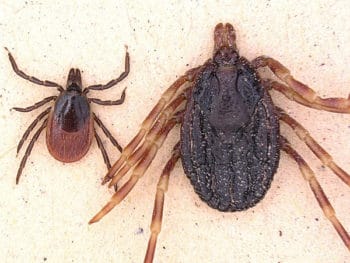Dangerous Hyalomma tick, moved to the now also increasingly in Germany
Dangerous Hyalomma tick in Schleswig-Holstein demonstrated
In Schleswig-Holstein, the dangerous Hyalomma has been proven-tick – in the Winter! This tick species is actually native to southern climes. The blood-suckers can transmit, among other things, the life threatening Crimean-Congo fever Virus.
Non-native tick species found
In the past few months, health experts have reported increasingly facing a growing danger from ticks. The little blood suckers can transmit infectious diseases such as Lyme disease and tick-borne encephalitis (TBE). Meanwhile, non-native species on a scuba-diving here – and even in the Winter. So recently, the dangerous Hyalomma was found-tick in the North of Germany.

For the first time Hyalomma tick in Schleswig-Holstein demonstrated
In Schleswig-Holstein, Hyalomma for the first time-tick proven. According to a report of the NDR, the animal of a Rider was spotted on a horse in Bokelholm (Rendsburg-Eckernförde).
The woman sent the blood sucker to the Robert-Koch-Institute (RKI) for tropical medicine in Hamburg.
This tick species is actually native to southern Europe, Asia and Africa, it was established in the past few months, but also several times in Germany.
Significantly larger than the wood tick
The Hyalomma tick is about five Times as large as the country’s native tick species of wood Bock.
Dr. Peter Hagedorn, ticks, researchers at the RKI, to the NDR stated, you can run the little animal with its striking, striped, hairy legs, quickly and chases his victims up to 100 meters.
According to the experts, the Hyalomma tick is very dangerous, “because they can transmit viruses that have been in Germany before, but not yet transferred.”
So the blood suckers can transmit the Crimean-Congo haemorrhagic fever Virus, severe internal bleeding caused and even can be fatal.
Life-Threatening Crimean-Congo Fever
The Crimean-Congo fever also appears on a list of diseases and disease agents, which represent, according to the world health organization (WHO), “a risk to public health and for which there is no or inadequate counter-measures”, such as the organization writes on its website.
For these diseases, an accelerated research is “in the light of their potential to cause a public health emergency, and the lack of effective drugs and/or vaccines are” urgently needed.
The disease is most recently caused by a number of cases in Turkey but also in Spain for attention.
It is also so important, because there is still no vaccine.
However, the timely treatment with an anti-viral agent can prevent the fatal outcome of the disease.
Hyalomma can withstand temperatures of up to minus 40 degrees
So far, only a few specimens of Hyalomma were nationwide found-tick. None of the animals in the Crimea-Congo Virus wore.
However, experts are alarmed, as the blood-suckers come with the migratory birds to Germany. Perhaps you could establish itself in this country.
“These species of Ticks could hold in Germany,” said Prof. Dr. Ute Mackenstedt, Parasitology login at the University of Hohenheim in a message.
“Because of the warming of the climate is, in principle, with more and more heat is to be expected loving ticks”, says the expert.
And also with cold, Hyalomma, it copes well. According to Dr. Hagedorn by RKI she feels in the tropical heat well, but can survive temperatures up to minus 40 degrees.
Nevertheless, researchers are not sure whether or not this tick species can survive the Winter. The RKI according to experts, one should check whether it occurs again next year, and in what number. (ad)


